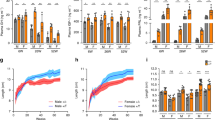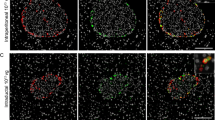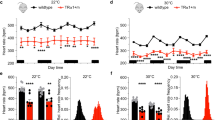Abstract
CYCLIC AMP1 is thought to act as an intracellular second messenger, mediating the physiological response of many cell types to extracellular signals2,3. In the pituitary, growth hormone (GH)-producing cells (somatotrophs) proliferate and produce GH in response to hypothalamic GH-releasing factor4-8, which binds a receptor that stimulates Gs protein activation of adenylyl cyclase3,9-12. We have now determined whether somatotroph proliferation and GH production are stimulated by cAMP' alone5,7,11,13-15, or require concurrent, non-Gs-mediated induction of other regulatory molecules by designing a transgene to induce chronic supraphysiological concentrations of cAMP in somatotrophs. The rat GH promoter16,17 was used to express an intracellular form of cholera toxin18, a non-cytotoxic and irreversible activator of Gs (ref. 19). Introduction of this transgene into mice caused gigantism, elevated serum GH levels, somatotroph proliferation and pituitary hyperplasia. These results support the direct triggering of these events by cAMP, and illustrate the utility of cholera toxin transgenes as a tool for physiological engineering.
This is a preview of subscription content, access via your institution
Access options
Subscribe to this journal
Receive 51 print issues and online access
$199.00 per year
only $3.90 per issue
Buy this article
- Purchase on Springer Link
- Instant access to full article PDF
Prices may be subject to local taxes which are calculated during checkout
Similar content being viewed by others
References
Sutherland, E. W. & Rall, T. W. J. Am. chem. Soc. 79, 3608 (1957).
Robison, G. A., Butcher, R. W. & Sutherland, E. W. A. Rev. Biochem. 37, 149–174 (1968).
Neer, E. J. & Clapham, D. E. Nature 333, 129–134 (1988).
Asa, S. L. et al. J. clin. Endocr. Metab. 58, 796–803 (1984).
Barinaga, M., Bilezikjian, L. M., Vale, W. W., Rosenfeld, M. G. & Evans, R. M. Nature 314, 279–281 (1985).
Hammer, R. E., Brinster, R. L., Rosenfeld, M. G., Evans, R. M. & Mayo, K. E. et al. Nature 315, 413–416 (1985).
Billestrup, N., Swanson, L. W. & Vale, W. Proc. natn. Acad. Sci. U.S.A. 83, 6854–6857 (1986).
Asa, S. L. et al. Proc. Soc. exp. Biol. Med. 193, 232–235 (1990).
Bilezikjian, L. M. & Vale, W. W. Endocrinology 113, 1726–1731 (1983).
Smigel, M. et al. Adv. cyclic Nucl. Prot. Physphoryl. Res. 17, 1–18 (1984).
Vallar, L., Spada, A. & Giannattasio, G. Nature 330, 566–568 (1987).
Strutters, R. S., Perrin, M. H. & Vale, W. Endocrinology 124, 24–29 (1989).
Schofield, J. G. Nature 215, 1382–1383 (1967).
Bourne, H. R. Nature 330, 517–518 (1987).
Landis, C. A. et al. Nature 340, 692–696 (1989).
Barta, A., Richards, R. I., Baxter, J. D. & Shine, J. Proc. natn. Acad. Sci. U.S.A. 78, 4867–4871 (1981).
Behringer, R. R., Mathews, L. S., Palmiter, R. D. & Brinster, R. L. Genes Dev. 2, 453–461 (1988).
Mekalanos, J. J. et al. Nature 306, 551–557 (1983).
Gill, D. M. & Meren, R. Proc. natn. Acad. Sci. U.S.A. 75, 3050–3054 (1978).
Saiki, R. K. et al. Science 239, 487–491 (1988).
Kozak, M. Nucleic Acids Res. 12, 857–872 (1984).
Palmiter, R. D. et al. Cell 50, 435–443 (1987).
Hoeffler, J. P., Boockfor, F. R. & Frawley, L. S. Endocrinology 117, 187–195 (1985).
Stefaneanu, L. et al. Endocrinology 125, 2710–2718 (1989).
Middlebrook, J. L. & Dorland, R. B. Microbiol. Rev. 48, 199–221 (1984).
Gordon, J. W., Scangos, G. A., Plotkin, D. J., Barbosa, J. A. & Ruddle, F. H. Proc. natn. Acad. Sci. U.S.A. 77, 7380–7384 (1980).
Brinster, R. L. et al. Cell 27, 223–231 (1981).
Author information
Authors and Affiliations
Rights and permissions
About this article
Cite this article
Burton, F., Hasel, K., Bloom, F. et al. Pituitary hyperplasia and gigantism in mice caused by a cholera toxin transgene. Nature 350, 74–77 (1991). https://doi.org/10.1038/350074a0
Received:
Accepted:
Issue Date:
DOI: https://doi.org/10.1038/350074a0
This article is cited by
-
Clinical implications of growth hormone–secreting tumor subtypes
Endocrine (2012)
-
The pathogenesis of pituitary tumours
Nature Reviews Cancer (2002)
-
A transgenic model of comorbid Tourette's syndrome and obsessive-compulsive disorder circuitry
Molecular Psychiatry (2002)
-
p27Kip1-deficient mice exhibit accelerated growth hormone-releasing hormone (GHRH)-induced somatotrope proliferation and adenoma formation
Oncogene (2000)
-
hpttg is over-expressed in pituitary adenomas and other primary epithelial neoplasias
Oncogene (1999)
Comments
By submitting a comment you agree to abide by our Terms and Community Guidelines. If you find something abusive or that does not comply with our terms or guidelines please flag it as inappropriate.



